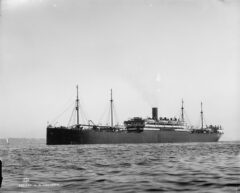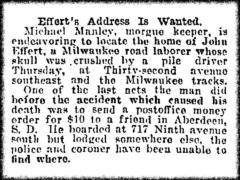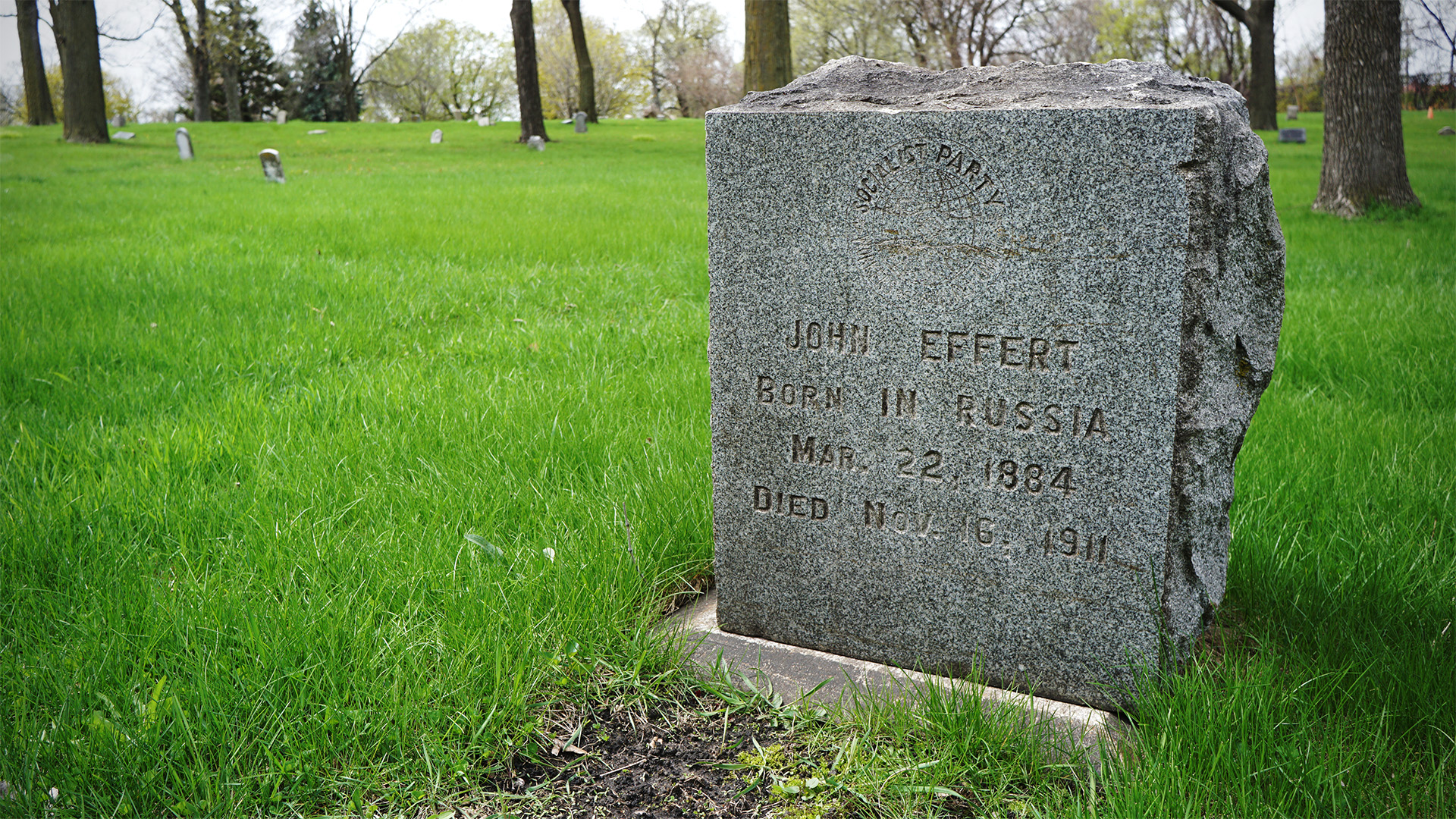Among the luminaries to emerge in Latvia during the early 20th century revolutionary period was Ernests Eferts-Klusais (1889-1927), a writer and teacher regarded as a talented and dedicated Marxist.1 However, this story is not about him, but about an older brother, Jānis, who became one of the first Latvian immigrants to die in Minnesota.
Jānis Eferts (John Effert) is buried in the Pioneers and Soldiers Memorial Cemetery in south Minneapolis and his headstone — engraved with the logo of the Socialist Party — is one of the more unusual. The headstone was even noted in documents submitted in 2002 when the cemetery was added to the National Register of Historic Places.
Ernests and Jānis were part of a large family that lived at Vāne, southwest of the Latvian town of Kandava — at the time part of the sprawling Russian Empire. Jānis, born in 1884, was the second oldest son in the family after Fridrihs (Fricis). Ernests was born in 1889.
Little is known about Jānis and his early life. In 1901, he graduated from the Gorky School of Surveying in Mogilev in what is now Belarus. He returned for a while to Vāne to live with his parents (Ernests Sr. and Late) and siblings, and it was perhaps at this point that he had the greatest influence on young Ernests. At the Gorky school, according to a biography of Ernests by Ingrīda Kiršentāle2, Jānis had been exposed to Marxist philosophy. He passed on to Ernests lessons about class struggle.

“The obituary Ernests wrote for his brother reveals that Jānis was one of the first, if not the very first, to introduce Ernests to understanding class struggle, to tell him about revolution and the society of the future,” Kiršentāle wrote.
Events during the 1905 Revolution had an effect on the family. Fricis organized political meetings. Ernests was still in high school, but no doubt aware of the unrest in the countryside and in Rīga, where he was studying the natural sciences. And Jānis was in the czar’s army, stationed in Kaunas, Lithuania, where in 1906 he was among soldiers involved in an uprising. After that, he was forced to emigrate.
The 22-year-old Jānis arrived in New York in October 1906 aboard the steamship Pretoria, which had sailed to America from Hamburg, Germany, according to the passenger list.3 It is not known how long he stayed in New York, but by late 1909 he had arrived in Minneapolis, according to his Declaration of Intention filed in Hennepin County District Court.4
Many of the roughly 100 Latvian immigrants in Minneapolis were socialists. A good share belonged to the local branch of the Socialist Party of America’s National Lettish Organization (the koporganizācija, as it was known in Latvian), while a minority had joined the Latvian federation of the rival Socialist Labor Party. Eferts chose the former.
Like many other Latvian immigrants, Eferts found a room in the Seven Corners district of Minneapolis. And, like others, he worked in different jobs. The city directory5 for 1910 listed him as a laborer, while the 1910 federal census reported that he was a “huckster” of fruits and vegetables. When he died, Eferts was working for the Northern Pacific railroad company.

Eferts was killed November 16, 1911, by a pile driver, the Minneapolis Tribune reported on November 19.6 He was 26 years old.
Members of the Minneapolis local of the koporganizācija took care of his affairs, apparently organizing both his burial and handling his meager estate.
“He was a good comrade and a good person,” Kārlis Dirba, a leading Latvian socialist in Minneapolis, wrote later.7 He noted that Eferts was planning to continue his training as a surveyor.
Dirba also was appointed as appraiser of Eferts’ estate, which amounted to clothes, some cash, and carpenter’s tools.8 The only heir listed in Hennepin County probate records was Eferts’ mother back in Latvia.
Obscurity has been the fate of plenty of immigrants to the United States. At least the friends of Jānis Eferts made sure he would not be forgotten forever.
1. Like many Latvian revolutionaries of the time, Ernests Eferts adopted a nom-de-guerre. In his case, it was “Klusais” — the Quiet One.
2. Ingrīda Kiršentāle. Ernests Eferts-Klusais (Rīga: Latvijas PSR Zinātņu akadēmija, 1962).
3. Jan Effert entry; SS Pretoria Passenger Manifest, October 19, 1906, page 123, line 22; Micropublication T715 (Washington: National Archives), roll 0714, frame 245. (Ancestry.com. New York, Passenger and Crew Lists (including Castle Garden and Ellis Island), 1820-1957 [database on-line]. Provo, UT, USA: Ancestry.com Operations, Inc., 2010.)
4. John Effert declaration of intention, 1909, Minnesota, Hennepin County District Court, volume 14, book 6, page 294.
5. Davison’s Minneapolis City Directory, vol. XXXVII, 1910 (Minneapolis: Minneapolis Directory Co., 1910), p. 549.
6. The Latvian socialist newspaper Strādnieks, published in Boston, reported the news on December 12, 1911.
7. R. Endrups and A. Feldmanis, Revolucionārās cīņās kritušo piemiņas grāmata, 2. sējums, 1907-1917 (Moscow: Prometejs, 1936) p. 424. One remembrance was written by Ernests Eferts-Klusais, the other by Kārlis Dirba. The entry for Eferts is preceeded by one for Kārlis Timermans, who died in September 1911 in Minneapolis.
8. Hennepin County, Minnesota, probate case files, estate no. 014237, John Effert (1912), Petition for Administration, February 13, 1912, and Inventory and Appraisement, July 3, 1912; Records Center, Hennepin County District Court, Minneapolis.
Accessed on 23 Apr 2024.
The article may be found online at https://straumanis.com/2019/john-effert/.

